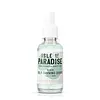What's inside
What's inside
 Key Ingredients
Key Ingredients

 Benefits
Benefits

 Concerns
Concerns

 Ingredients Side-by-side
Ingredients Side-by-side

Water
Skin ConditioningDihydroxyacetone
Skin ConditioningAlcohol Denat.
AntimicrobialGlycerin
HumectantPolysorbate 80
EmulsifyingXanthan Gum
EmulsifyingErythrulose
TanningPropylene Glycol
HumectantTropaeolum Majus Flower/Leaf/Stem Extract
Skin ConditioningTocopheryl Acetate
AntioxidantAloe Barbadensis Extract
Skin ConditioningCitrus Grandis Peel Oil
MaskingCocos Nucifera Oil
MaskingEucalyptus Globulus Leaf Oil
PerfumingMentha Piperita Oil
MaskingPersea Gratissima Oil
Skin ConditioningSalvia Hispanica Seed Oil
MoisturisingSalvia Officinalis Oil
MaskingMethoxyphenyl T-Butylphenyl Propanediol
Skin ConditioningAgastache Mexicana Flower/Leaf/Stem Extract
Skin ConditioningAscorbic Acid
AntioxidantPropanediol
SolventEthylhexylglycerin
Skin ConditioningSodium Metabisulfite
AntioxidantParfum
MaskingSodium Hydroxide
BufferingPhenoxyethanol
PreservativeTriethylene Glycol
MaskingWater, Dihydroxyacetone, Alcohol Denat., Glycerin, Polysorbate 80, Xanthan Gum, Erythrulose, Propylene Glycol, Tropaeolum Majus Flower/Leaf/Stem Extract, Tocopheryl Acetate, Aloe Barbadensis Extract, Citrus Grandis Peel Oil, Cocos Nucifera Oil, Eucalyptus Globulus Leaf Oil, Mentha Piperita Oil, Persea Gratissima Oil, Salvia Hispanica Seed Oil, Salvia Officinalis Oil, Methoxyphenyl T-Butylphenyl Propanediol, Agastache Mexicana Flower/Leaf/Stem Extract, Ascorbic Acid, Propanediol, Ethylhexylglycerin, Sodium Metabisulfite, Parfum, Sodium Hydroxide, Phenoxyethanol, Triethylene Glycol
PEG-2 Distearate
Emulsifying1,2-Hexanediol
Skin ConditioningDiisostearyl Malate
EmollientSodium Hyaluronate
Humectant3-O-Ethyl Ascorbic Acid
Skin ConditioningAmmonium Acryloyldimethyltaurate/Vp Copolymer
Panthenol
Skin ConditioningCetyl Alcohol
EmollientSqualane
EmollientCetearyl Alcohol
EmollientDaucus Carota Sativa Seed Oil
EmollientGlyceryl Stearate Se
EmulsifyingGlyceryl Stearate
EmollientPEG-100 Stearate
Arbutin
AntioxidantXanthan Gum
EmulsifyingSynthetic Beeswax
Emulsion StabilisingParfum
MaskingHydroxyethyl Acrylate/Sodium Acryloyldimethyl Taurate Copolymer
Emulsion StabilisingEthylhexylglycerin
Skin ConditioningGlyceryl Acrylate/Acrylic Acid Copolymer
HumectantPolysorbate 60
EmulsifyingSodium Phytate
Sorbitan Isostearate
EmulsifyingTocopherol
AntioxidantBenzyl Salicylate
PerfumingCoumarin
PerfumingPEG-2 Distearate, 1,2-Hexanediol, Diisostearyl Malate, Sodium Hyaluronate, 3-O-Ethyl Ascorbic Acid, Ammonium Acryloyldimethyltaurate/Vp Copolymer, Panthenol, Cetyl Alcohol, Squalane, Cetearyl Alcohol, Daucus Carota Sativa Seed Oil, Glyceryl Stearate Se, Glyceryl Stearate, PEG-100 Stearate, Arbutin, Xanthan Gum, Synthetic Beeswax, Parfum, Hydroxyethyl Acrylate/Sodium Acryloyldimethyl Taurate Copolymer, Ethylhexylglycerin, Glyceryl Acrylate/Acrylic Acid Copolymer, Polysorbate 60, Sodium Phytate, Sorbitan Isostearate, Tocopherol, Benzyl Salicylate, Coumarin
 Reviews
Reviews

Ingredients Explained
These ingredients are found in both products.
Ingredients higher up in an ingredient list are typically present in a larger amount.
Ethylhexylglycerin (we can't pronounce this either) is commonly used as a preservative and skin softener. It is derived from glyceryl.
You might see Ethylhexylglycerin often paired with other preservatives such as phenoxyethanol. Ethylhexylglycerin has been found to increase the effectiveness of these other preservatives.
Parfum is a catch-all term for an ingredient or more that is used to give a scent to products.
Also called "fragrance", this ingredient can be a blend of hundreds of chemicals or plant oils. This means every product with "fragrance" or "parfum" in the ingredients list is a different mixture.
For instance, Habanolide is a proprietary trade name for a specific aroma chemical. When used as a fragrance ingredient in cosmetics, most aroma chemicals fall under the broad labeling category of “FRAGRANCE” or “PARFUM” according to EU and US regulations.
The term 'parfum' or 'fragrance' is not regulated in many countries. In many cases, it is up to the brand to define this term.
For instance, many brands choose to label themselves as "fragrance-free" because they are not using synthetic fragrances. However, their products may still contain ingredients such as essential oils that are considered a fragrance by INCI standards.
One example is Calendula flower extract. Calendula is an essential oil that still imparts a scent or 'fragrance'.
Depending on the blend, the ingredients in the mixture can cause allergies and sensitivities on the skin. Some ingredients that are known EU allergens include linalool and citronellol.
Parfum can also be used to mask or cover an unpleasant scent.
The bottom line is: not all fragrances/parfum/ingredients are created equally. If you are worried about fragrances, we recommend taking a closer look at an ingredient. And of course, we always recommend speaking with a professional.
Learn more about ParfumXanthan gum is used as a stabilizer and thickener within cosmetic products. It helps give products a sticky, thick feeling - preventing them from being too runny.
On the technical side of things, xanthan gum is a polysaccharide - a combination consisting of multiple sugar molecules bonded together.
Xanthan gum is a pretty common and great ingredient. It is a natural, non-toxic, non-irritating ingredient that is also commonly used in food products.
Learn more about Xanthan Gum